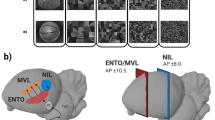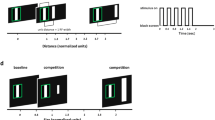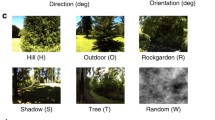Summary
InSalamandra salamandra prey-catching behavior was investigated quantitatively in response to moving visual stimuli with the following Gestalt parameters: squares (S), worm-like (W), and antiworm-like (A) stripes of different sizes. It can be shown that the worm vs. antiworm preference is invariant irrespective of changes of the stimulus angular velocity, which contradicts earlier claims made by Luthardt and Roth (1979).
The activity of 47 tectal neurons in response to the same changing Gestalt parameters was recorded extracellularly and investigated quantitatively. Various classes of monocularly driven neurons can be distinguished according to their different ERF sizes; they correspond to large field class T2 neurons (ERF≃100 °), and T4 neurons (ERF≧ 100 °), and to small field T5 neurons (ERF≃34 °) described earlier in frogs and toads.
If the configurational (W, A) response properties of tectal neurons are considered, further (sub-)-classifications can be made with regard to worm preference (1), antiworm preference (3), and selective responses to large areas (4). Whereas class T5(1), T2(3), and T5(3) neurons have also been recorded from the tectum of toads and frogs, class T4(4) and T5(4) neurons appear to be unique toS. salamandra. In the fire salamander, class T5(1) neurons may fulfill functions of command elements in a system that generates the appropriate motor pattern of the prey-catching sequence. Class T5(4) and T4(4) neurons, on the other hand, are suitable candidates for command elements in another system that generates escape behavior.
No class T5(2) neurons have been identified inS. salamandra. It is suggested that highly selective class T5(2) neurons in anurans have evolved concurrently with the parcellation of the dorsal thalamus.
Similar content being viewed by others
Abbreviations
- A :
-
antiworm-like stripe
- ERF :
-
excitatory receptive field
- D W,A :
-
discriminate value
- S :
-
square
- W :
-
worm-like stripe
Reference
Borchers H-W, Ewert J-P (1979) Correlation between behavioral and neuronal activities of toadsBufo bufo (L.) in response to moving configurational prey stimuli. Behav Processes 4:99–106
Bullock TH (1983) Implications for neuroethology from comparative neurophysiology. In: Ewert J-P, Capranica RR, Ingle DJ (eds) Advances in vertebrate neuroethology. Plenum Press, New York, pp 53–75
Clairambault P (1976) Development of the prosencephalon. In: Llinás R, Precht W (eds) Frog neurobiology. Springer, Berlin Heidelberg New York, pp 924–945
Ebbesson SOE (1980) The parcellation theory and its relation to interspecific variability in brain organization, evolutionary and ontogenetic development, and neural plasticity. Cell Tissue Res 213:179–212
Ebbesson SOE (1983) Neuroanatomical implications for neuroethology. In: Ewert J-P, Capranica RR, Ingle DJ (eds) Advances in vertebrate neuroethology. Plenum Press, New York, pp 77–89
Ewert J-P (1968) Der Einfluβ von Zwischenhirndefekten auf die Visuomotorik im Beute- und Fluchtverhalten der Erdkröte (Bufo bufo L.). Z Vergl Physiol 61:41–70
Ewert J-P (1969) Quantitative Analyse von Reiz-Reaktionsbeziehungen bei visuellem Auslösen der Beutefangwendereaktionen der Erdkröte (Bufo bufo L.). Pflügers Arch 308:225–243
Ewert J-P (1980) Neuroethology. Springer, Berlin Heidelberg New York
Ewert J-P (1983/84) Tectal mechanisms underlying prey-catching and avoidance behaviors in toads. In: Vanegas H (ed) Comparative neurology of the optic tectum. Plenum Press, New York, (in press)
Ewert J-P, Burghagen H (1979a) Ontogenetic aspects on visual ‘size-constancy’ phenomena in the midwife toadAlytes obstetricans (Laur.). Brain Behav Evol 16:99–112
Ewert J-P, Burghagen H (1979b) Configurational prey selection byBufo, Alytes, Bombina andHyla. Brain Behav Evol 16:157/175
Ewert J-P, Wietersheim A von (1974) Musterauswertung durch tectale und thalamus/praetectale Nervennetze im visuellen System der Kröte (Bufo bufo L.). J Comp Physiol 91:131–148
Ewert J-P, Borchers H-W, Wietersheim A von (1978) Question of prey feature detectors in the toad'sBufo bufo (L.) visual system: A correlation analysis. J Comp Physiol 126:43–47
Ewert J-P, Burghagen H, Schürg-Pfeiffer E (1983) Neuroethological analysis of the innate releasing mechanism for preycatching behavior in toads. In: Ewert J-P, Capranica RR, Ingle DJ (eds) Advances in vertebrate neuroethology. Plenum Press, New York, pp 413–475
Finkenstädt Th (1980) Disinhibition of prey-catching in the salamander following thalamic-pretectal lesions. Naturwissenschaften 67:471
Finkenstädt Th (1981) Effects of forebrain lesions on visual discrimination inSalamandra salamandra. Naturwissenschaften 68:268
Finkenstädt Th (1983) Influence of the optic tectum and prosencephalic structures on visually controlled prey-catching and avoidance behaviors in the fire salamander. In: Ewert J-P, Capranica RR, Ingle DJ (eds) Advances in vertebrate neuroethology. Plenum Press, New York, pp 585–594
Finkenstädt Th, Ewert J-P (1983) Visual pattern discrimination through interactions of neural networks: A combined electrical brain stimulation, brain lesion, and extracellular recording study inSalamandra salamandra. J Comp Physiol 153:99–110
Fritzsch B (1980) Retinal projections in European Salamandridae. Cell Tissue Res 213:325–341
Grobstein P, Comer Ch, Kostyk SK (1983) Frog prey capture behavior: between sensory maps and directed motor output. In: Ewert J-P, Capranica RR, Ingle DJ (eds) Advances in vertebrate neuroethology. Plenum Press, New York, pp 331–347
Grüsser OJ, Grüsser-Cornehls U (1976) Neurophysiology of the anuran visual system. In: Llinás R, Precht W (eds) Frog neurobiology. Springer, Berlin Heidelberg New York, pp 297–385
Grüsser-Cornehls U, Himstedt W (1976) The urodele visual system. In: Fite KV (ed) The amphibian visual system. Academic Press, New York San Francisco London, pp 203–266
Himstedt W (1982) Prey selection in salamanders. In: Ingle DJ, Goodale MA, Mansfield JW (eds). The analysis of visual behavior. The MIT Press, Cambridge, Mass
Himstedt W, Fischerleitner E (1975) Die Antworten von Retinaneuronen auf Farbreize bei Urodelen. Zool Jahrb Physiol 79:128–147
Himstedt W, Roth G (1980) Neuronal responses in the tectum opticum ofSalamandra to visual prey stimuli. J Comp Physiol 135:251–257
Himstedt W, Freidank U, Singer E (1976) Die Veränderung eines Auslösemechanismus im Beutefangverhalten während der Entwicklung vonSalamandra salamandra (L.). Z Tierpsychol 41:235–243
Kupfermann I, Weiss KR (1978) The command neuron concept. Behav Brain Sci 1:3–39
Luthardt G, Roth G (1979) The relationship between stimulus orientation and stimulus movement pattern in the preycatching behavior ofSalamandra salamandra. Copeia 1979:442–447
Roth G (1982) Beuteerkennungsmechanismen im Tectum opticum von Amphibien — eine vergleichende Untersuchung. Funkt Biol Med 1:90–98
Sachs L (1976) Statistische Methoden. Springer, Berlin Heidelberg New York
Schürg-Pfeiffer E, Ewert J-P (1981) Investigation of neurons involved in the analysis of Gestalt prey features in the frogRana temporaria. J Comp Physiol 141:139–152
Weerasuriya A (1983) Snapping in toads: some aspects of sensorimotor interfacing and motor pattern generation. In: Ewert J-P, Capranica RR, Ingle DJ (eds) Advances in vertebrate neuroethology. Plenum Press, New York, pp 613–627
Weerasuriya A, Ewert J-P (1981) Prey-selective neurons in the toad's optic tectum and sensori-motor interfacing: HRP studies and recording experiments. J Comp Physiol 144:429–434
Witpaard J (1976) Frog's vision. Nat thesis, Leiden
Author information
Authors and Affiliations
Rights and permissions
About this article
Cite this article
Finkenstädt, T., Ewert, J.P. Processing of area dimensions of visual key stimuli by tectal neurons inSalamandra salamandra . J. Comp. Physiol. 153, 85–98 (1983). https://doi.org/10.1007/BF00610346
Accepted:
Issue Date:
DOI: https://doi.org/10.1007/BF00610346




